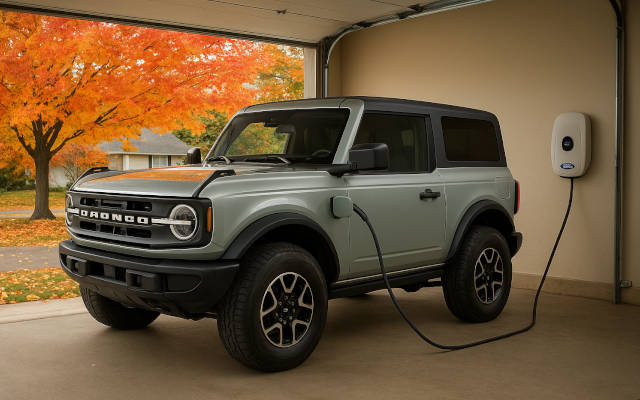Ford Faces EV Crossroads as Federal Incentives Expire

ChatGPT envisions Ford Bronco PHEV
By EVWorld.com Si Editorial Team
EV Sales at Risk
With the expiration of the $7,500 federal electric vehicle tax credit, Ford finds itself at a pivotal moment in its electrification strategy. CEO Jim Farley recently warned that EV sales could be cut in half without the subsidy, dropping from 10–12% of the U.S. auto market to just 5%. His message was clear: the industry has leaned heavily on predictable government support, and the sudden policy shift could stall momentum just as EV adoption was gaining traction.
Consumer Price Sensitivity
Farley’s remarks came during the Ford Pro Accelerate summit in Detroit, where he emphasized that while electric vehicles are fast, efficient, and technologically advanced, they remain out of reach for many consumers. “They find them interesting,” he said, “but they’re expensive.” Without the tax credit, the sticker shock of a $75,000 EV becomes a dealbreaker for mainstream buyers, especially in a cooling economy.
Financial Pressures and Market Trends
The timing couldn’t be more critical. Ford’s EV division posted a $1.3 billion loss in Q2 and is on track to lose up to $5.5 billion this year. Meanwhile, Q3 saw record EV sales across the industry — over 410,000 units — as buyers rushed to take advantage of the final days of the incentive. But analysts expect a sharp drop in Q4, with demand softening as prices rise and consumer uncertainty grows.
Ford’s Strategic Pivot
In response, Ford is pivoting. Farley announced a renewed focus on hybrids and plug-in hybrids, calling them “a bridge to full electrification.” These vehicles offer lower costs, familiar driving experiences, and fewer infrastructure hurdles — all attractive features for buyers who aren’t ready to go fully electric. Ford is also exploring more affordable EV models, aiming to bring prices down without sacrificing performance or safety.
Dealer Optimism and Market Testing
Interestingly, not everyone in the industry shares Farley’s concern. Some dealers see the end of federal incentives as an opportunity to test the true market viability of EVs. Without subsidies, they argue, automakers will be forced to compete on product quality, brand loyalty, and real-world value — not just price tags padded by government support. Ford, for its part, is offering alternative incentives, including competitive lease deals and dealer-backed discounts, to help soften the blow.
Looking Ahead
The next few quarters will be a stress test for the EV market. Will consumer interest hold without subsidies? Can automakers deliver compelling, affordable electric vehicles at scale? And will hybrids reclaim the spotlight as a practical compromise? For Ford, the answers to these questions will shape not just its product lineup, but its long-term identity in a rapidly evolving automotive landscape.
Read More
- MSN: Ford Boss Warns EV Sales Could Collapse
- CNBC: Ford CEO on EV Incentives
- CBT News: Automakers Post Record Q3
- CBT News: Ford CEO Warns of EV Sales Drop
Original Backlink
Views: 78
Articles featured here are generated by supervised Synthetic Intelligence (AKA "Artificial Intelligence").
